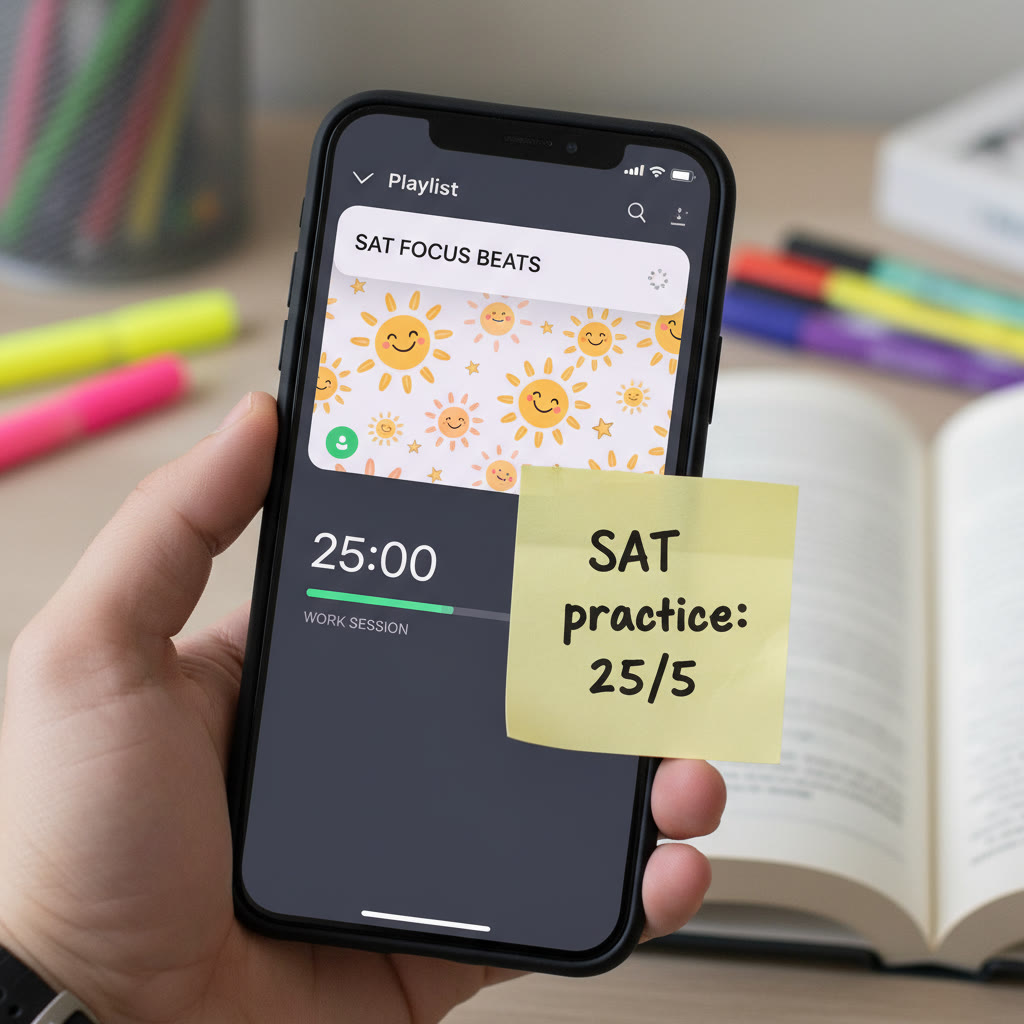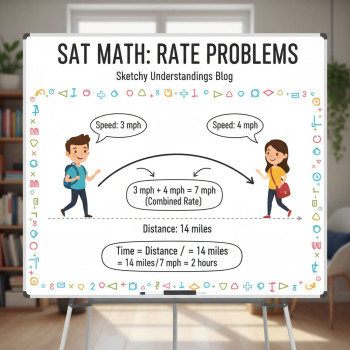How to Use Focus Music Apps for SAT Preparation
Picture this: it’s two weeks before the SAT, the clock is ticking, and you want every study minute to count. You’ve heard that music can help you focus, but you’re not sure which tracks actually help, when to use silence, or whether headphones are a productivity hack or a distraction. This guide walks you through practical, research-informed ways to use focus music apps to make SAT study sessions calmer, more efficient, and — importantly — more productive.
Whether you’re tackling a Verbal passage, drilling algebra, or writing practice essays, the right soundscape can help you enter a flow state and sustain attention. You’ll find explanations of different music types, step-by-step routines, a sample schedule table, and tips for measuring what works. I’ll also point out how Sparkl’s personalized tutoring can gently fold music-based strategies into your tailored study plan when it makes sense.

Why music helps — the science in plain English
Music doesn’t magically make you smarter, but it can change the conditions that make learning easier. Here’s what actually happens:
- Reduced perceived effort: Music can make monotonous tasks feel less tiring. When a practice set feels easier, you’re more likely to keep going and build beneficial repetition.
- Mood regulation: Calm or upbeat music can lower anxiety and lift motivation. Lower anxiety is particularly helpful during timed SAT practice when nerves can slow thinking.
- Attention shaping: Certain types of sound decrease background distractions and help you sustain focus. That said, the effect depends on the person and task.
- Pace synchronization: Fast, rhythmic tracks can increase energy and tempo; slower, steady beats can help with thoughtful, careful work.
Neuroscience studies often point to mechanisms like dopamine release (which supports motivation) and entrainment (where brain rhythms sync to a beat). However, you should treat these findings as useful rules of thumb, not rigid laws. Everyone’s brain responds differently, so small experiments are the best way to find your personal sweet spot.
Which types of focus music work best for SAT study?
Not all music is created equal for studying. Lyrics, sudden changes in tempo, or highly emotional songs can interrupt cognitive tasks. Below are practical categories and the SAT tasks where they typically fit best.
Instrumental music (classical, piano, ambient)
Why it works: No words mean fewer verbal interruptions when you’re reading or editing. Melodies and harmonies can soothe anxiety without drawing attention.
Best for: Reading passages, Writing and Language editing, timed practice essays.
Lo-fi and chillhop
Why it works: Lo-fi often combines steady beats with mellow textures, making it great for maintaining a calm but alert state.
Best for: Long practice blocks, particularly mixed question sets where you want to stay in the zone without peaks of excitement.
Binaural beats and isochronic tones
Why it works: These use slightly different frequencies in each ear to encourage brainwave alignment. Some people report improved concentration, though evidence is mixed and effects are subtle.
Best for: Short, focused drills where you want to try nudging your alertness. Use them cautiously and only if you find them pleasant.
White noise and naturals (rain, ocean)
Why it works: These steady sounds mask background interruptions and can be especially useful when studying in noisy places.
Best for: Quieting a loud study environment or when practicing on a noisy morning at home or a busy café.
Voice-free electronic / minimal techno
Why it works: A repetitive electronic pulse can support sustained attention during longer quantitative blocks.
Best for: Math problem sets and timed practice sections where quick, repeated thought processes are required.
Matching music to SAT tasks — quick cheat sheet
Use this practical framing: when the SAT task uses language processing (reading, grammar edits), minimize lyrical input; when it’s formulaic or repetitive (math drills), rhythms can help keep momentum.
- Reading passages: soft instrumental, piano or ambient.
- Writing & Language: instrumental or white noise to reduce sentence-level distraction.
- Math: steady beats like lo-fi or minimal electronic; white noise for noisy spaces.
- Practice essays: quiet instrumentals for planning, silence for actual timed writing if you find any sound distracts your typing flow.
How to structure SAT study sessions with music
Music should be an aid, not a band-aid for poor structure. Pair it with a robust study routine and clear goals. Below is a table with two sample routines — a focused 2-hour block and a longer 4-hour study day. Each row explains the task, recommended music type, and rationale.
| Time block | Task | Recommended music | Why |
|---|---|---|---|
| 00:00–00:25 | Pacing warm-up: quick mixed questions (timed) | Lo-fi, low volume | Gets you started without overstimulation; keeps tempo steady. |
| 00:25–00:30 | Short break | Silence or nature sounds | Reset attention; brief recovery from focused effort. |
| 00:30–01:00 | Focused reading passage practice | Instrumental piano or ambient | Minimizes verbal interference, supports deep comprehension. |
| 01:00–01:10 | Break + review mistakes | Silence | Quiet helps deliberate correction and note-taking. |
| 01:10–01:40 | Math problem set (medium difficulty) | Minimal electronic / steady lo-fi | Supports momentum for calculations and pattern spotting. |
| 01:40–02:00 | Timed practice essay (plan only) | Soft instrumental | Assists concentration for outlining and thesis work. |
For a 4-hour block, repeat the cycle twice, mixing in a longer lunch break and a 20–30 minute review session at the end. Rotate music types to prevent habituation — when your brain gets used to a sound, the ability of that sound to boost focus can diminish.
How to use focus music apps effectively
Modern focus music apps offer features that map well to SAT preparation. Instead of randomly picking a playlist, treat the app like a study tool.
Key app features to look for
- Timer / Pomodoro integration: Lets you set focused intervals with automatic transitions between music and silence. Use it to enforce breaks, which are essential for long study days.
- Offline playlists: Prevents streaming interruptions or distracting ads during a timed practice test.
- Customizable sound mix: Some apps blend ambient sounds with music — useful if you want white noise at low levels under a lo-fi track.
- Crossfade and volume ducking: Smooth transitions reduce jolts when changing tracks or when notifications come through (turn notifications off!).
- Focus modes: Modes for deep work vs. light review help you quickly select the right tempo and intensity.
Curated playlists vs. building your own
Curated playlists are convenient and have been tested on general audiences, so they’re a good starting point. However, building your own playlist allows you to control tempo, mood, and avoid songs that trigger memories or emotions that can derail focus. A hybrid approach works well: start with a curated list, remove tracks that distract you, and save the edited version for consistency.
How Sparkl’s personalized tutoring can help
Sparkl’s personalized tutoring isn’t about telling you what to listen to; it’s about creating a study plan that accounts for your learning habits. Tutors can suggest when to integrate music into your plan, recommend study session lengths, and help you measure whether certain soundscapes improve practice scores during 1-on-1 guidance. If you use Sparkl, your tutor can align playlists with targeted practice—so music becomes part of a coherent, data-driven routine rather than a guess.
Practical tips and common mistakes
Even with the best intentions, it’s easy to make small errors that reduce the effectiveness of focus music. Here are practical tips to avoid those traps.
Keep lyrics out of language-heavy tasks
When practicing reading comprehension or grammar, lyrics compete with the language centers of your brain. If you find yourself reading the words of a song or mouthing lyrics while trying to parse a passage, switch to instrumental options immediately.
Mind the volume and hearing health
Sound at high volumes can increase stress and damage hearing over time. Aim for a comfortable level where speech in the environment is muted but not painfully loud. Use the 60/60 rule: keep volumes at or below 60% and limit prolonged use to 60 minutes before a brief break.
Don’t rely on music during real test conditions
The official SAT is quiet; you won’t have music during the test. Use music to build study endurance, reduce procrastination, and manage mood — but periodically practice in silence to simulate test conditions and ensure your concentration doesn’t depend on external sound.
Avoid novelty traps
New playlists can be tempting but can also distract because your brain notices novelty. When it’s practice time, prefer familiar, proven playlists so attention stays on the task, not on discovering new sounds.
Headphones etiquette
Comfortable, closed-back headphones reduce outside noise better, but over-ear headphones can cause fatigue during multi-hour blocks. Lightweight in-ear monitors are fine for shorter sessions. Above all, choose what lets you study longest without irritation.
Simple experiments to find what works for you
Your response to music is personal. Run quick, repeatable tests to discover what actually helps you perform better on SAT-style tasks.
- A/B test format: Do two equivalent practice sections (e.g., two 25-minute reading passages). Use instrumental music for one and silence for the other. Compare accuracy, time-on-task, and how you felt.
- Short-term vs. long-term: Try a music strategy for a week with consistent playlists. Track practice scores and perceived focus each day to separate momentary placebo from real gains.
- Measure simple metrics: Correct per minute, number of questions completed, and self-rated focus on a 1–5 scale are easy and informative.
Keep a small study journal where you note the playlist, volume, task type, and outcome. Over time, that journal becomes a personalized atlas showing which sounds map to which tasks.
Real student examples — what worked in practice
Here are three quick, anonymized patterns students have used successfully:
- Sam, 11th grade: Used lo-fi playlists during 45-minute math blocks and found his completion rate improved because he lost less time transitioning between problems. He kept reading practice silent to preserve deep comprehension.
- Priya, 12th grade: Used binaural beats for 20 minutes before a timed practice to reduce test anxiety, then switched to piano for the actual section. She paired this with guided sessions from a Sparkl tutor who helped her decide when to use sound and when to practice in silence.
- Jordan, 10th grade: Lived in a noisy household and used low-level white noise for every study session. After testing, he realized white noise maintained his concentration almost as well as a quiet library and increased his weekly study consistency.
Wrapping up — practical plan you can start today
Here’s a compact, actionable checklist to start using focus music apps for your SAT prep this week:
- Pick two playlists: one instrumental (for verbal tasks) and one rhythmic/lo-fi (for math).
- Use a Pomodoro timer: 25–50 minute study windows with 5–10 minute breaks.
- Run a one-week A/B test to compare music vs. silence on similar practice sets.
- Lower the volume, choose comfortable headphones, and avoid lyrics for language tasks.
- Record outcomes in a study journal and adjust based on actual score changes and comfort.
Remember: music is a tool, not a crutch. It helps you shape a study environment where attention is easier to sustain, but it won’t replace deliberate practice. If you want help building a study plan that intelligently integrates music, Sparkl’s personalized tutoring offers 1-on-1 guidance, tailored study plans, expert tutors, and AI-driven insights to test and refine strategies that actually move your scores. That kind of guided experimentation can save you weeks of trial and error.
Give it a try: choose the playlist you’re calm with, set a clear goal for a study block, and notice whether your focus improves. With consistent, measured practice, the right soundscape can turn uncomfortable study hours into productive, even enjoyable sessions — and that steady progress is exactly what wins on test day.

Final encouragement
The SAT isn’t just a test of what you know; it’s a test of how well you can organize your thinking under pressure. Music apps are a small, practical lever you can use to optimize attention, manage stress, and create more consistent study habits. Try small experiments, keep notes, and let the data guide you. Keep your ears healthy, your playlists calm, and your goals clear — you’ll be surprised how much a thoughtful soundscape can help your studies sing.
Good luck — and if you want help turning your music-tuned habits into a full study plan, a Sparkl tutor can help you stitch everything together into a roadmap that fits your learning style.




















No Comments
Leave a comment Cancel